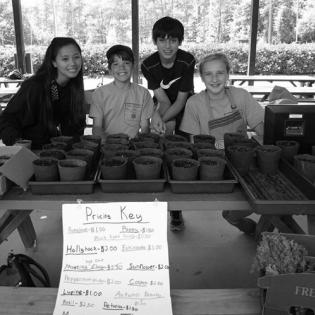Garden for Life
Through a story in which a child inspires her neighborhood to improve a vacant lot, young people recognize that they can have a positive impact on others. They brainstorm a philanthropic project to benefit the school or larger community.
The learner will:
- define philanthropist/philanthropy.
- plan and carry out a community project.
- read-aloud copy of Wanda’s Roses by Pat Brisson
- copies of An Action of the Heart (handout)
Families can discuss actions of the heart in the community and in the home. The handout, An Action of the Heart, includes some simple plant projects to do at home.
Brisson, Pat. Wanda’s Roses. Boyds Mills Press, 1994. ISBN: 156397925X
Instructions
Anticipatory Set:
Read Wanda’s Roses aloud, stopping to note details and check for understanding. What do the neighbors think of what Wanda is doing? How do they express their opinions? What is Wanda doing for the neighborhood? (Be sure to talk about the beautification as well as the sense of community.)
Say that Wanda’s actions for the common good make her a philanthropist. Review or introduce the definition of a philanthropist: someone who gives and shares time, talent and/or treasure for the common good. Discuss whether she set out to be a philanthropist. Why did she plant flowers?
Discuss whether she spent her time, talent, or treasure (or a combination) to make the neighborhood nicer. Discuss why acting philanthropically is good for the community.
Wanda’s actions came from her heart, and her good will spread to the entire neighborhood.
As a group, brainstorm things they could do to make some place better (neighborhood, classroom, home). List their ideas for some small and large actions for the common good. Make sure they include community gardening ideas (like Wanda’s garden).
Narrow the list to something the group or a family might like to do to brighten the neighborhood and stay within the rules and boundaries of community space. Brainstorm what common good they hope will come from their project (such as increased community interaction, beautifying an ugly space, increased community pride or ownership, or raised concern about common spaces).
Make a detailed plan of action, laying out all the steps, needed permission, and things needed to carry out the plan. Assign some responsibilities and begin working on whatever ideas can be started. Do it and then observe and reflect on the action and impact over time.
Some possible suggestions include the following: Plant trees at your school or at a community park. Start/maintain a school nature center. Start a community garden at a local park or community gathering place. Improve a community garden that is already in place. Beautify the school property.
Handouts
Philanthropy Framework
-
Strand PHIL.I Definitions of Philanthropy
-
Standard DP 01. Define Philanthropy
-
Benchmark E.1 Define philanthropy as the giving and sharing of time, talent, or treasure intended for the common good.
-
-
Standard DP 02. Roles of Government, Business, and Philanthropy
-
Benchmark E.6 Explain why acting philanthropically is good for the community, state, nation, or world.
-
-
-
Strand PHIL.II Philanthropy and Civil Society
-
Standard PCS 01. Self, citizenship, and society
-
Benchmark E.3 Describe a benefit of group cooperation.
-
-
